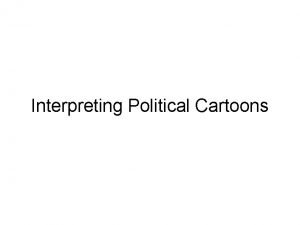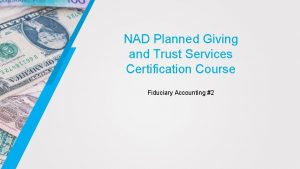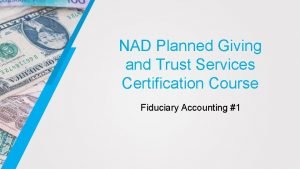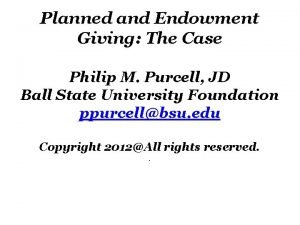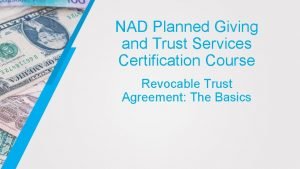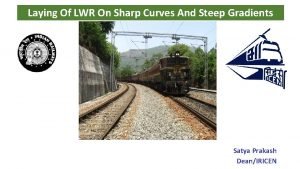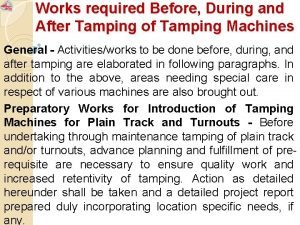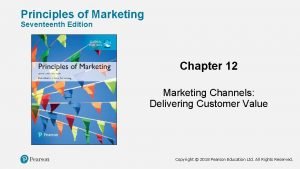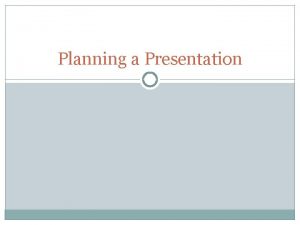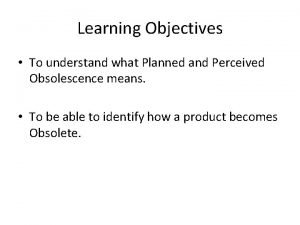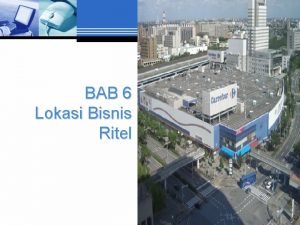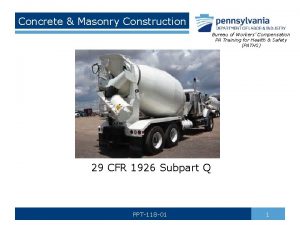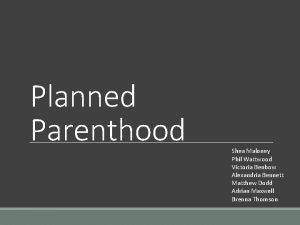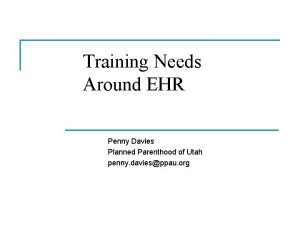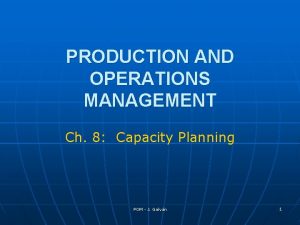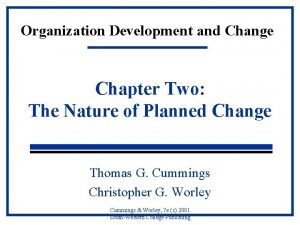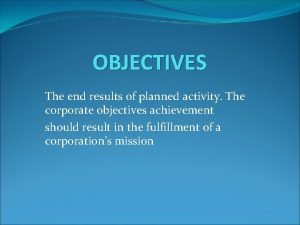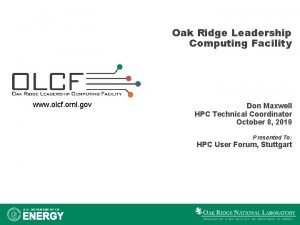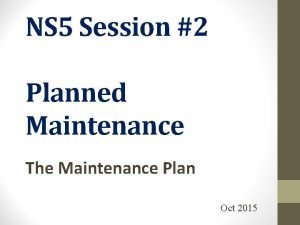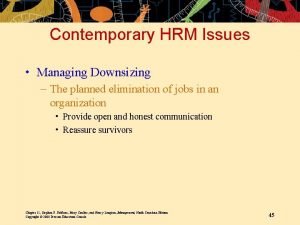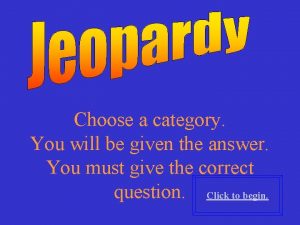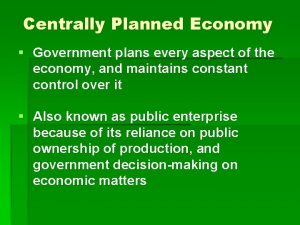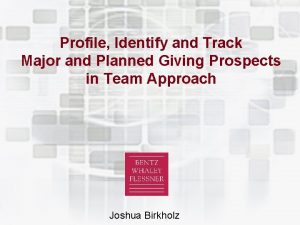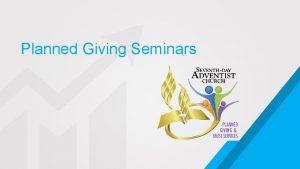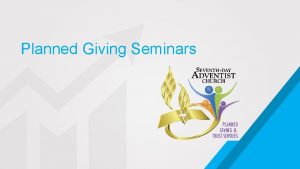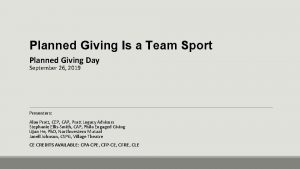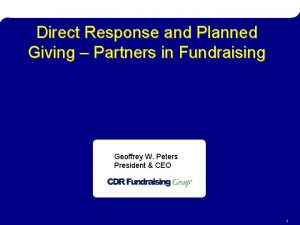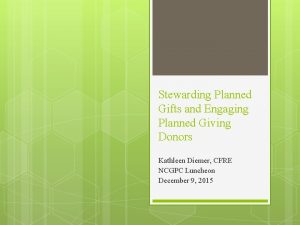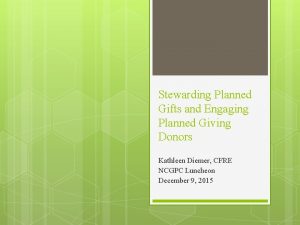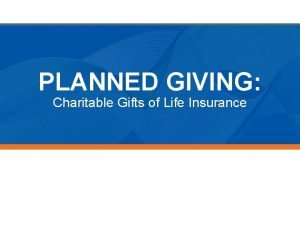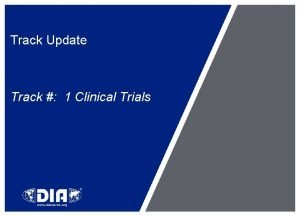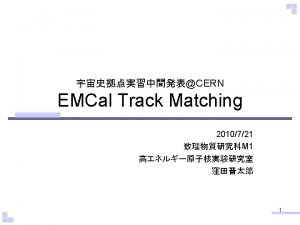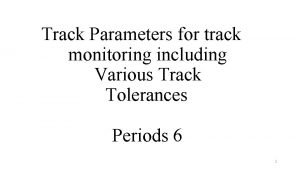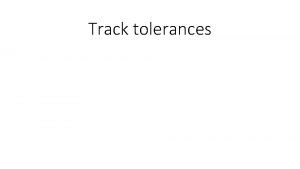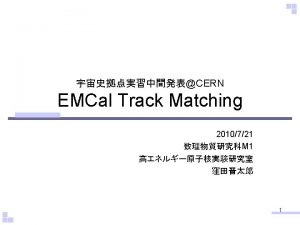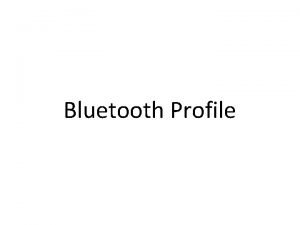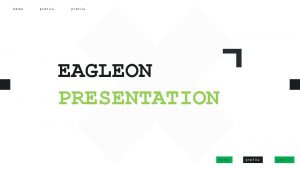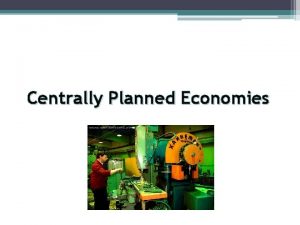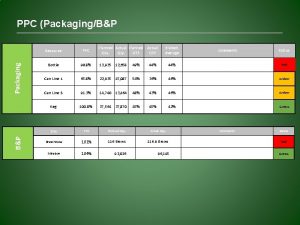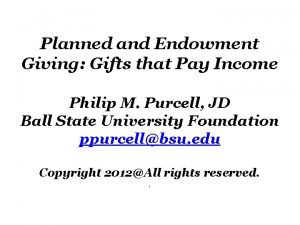Profile Identify and Track Major and Planned Giving


























- Slides: 26

Profile, Identify and Track Major and Planned Giving Prospects in Team Approach Joshua Birkholz © 2005 Bentz Whaley Flessner

Agenda Overview of principles and applications q. Identification and Profiling q. Prospect Management and Tracking 2 © 2005 Bentz Whaley Flessner

Elements of a major and planned gift development system 1. Base development 2. * Prospect identification 3. * Feeding and maintaining an active prospect pipeline 4. Major and planned gift cultivation 5. Donor relations or stewardship 3 © 2005 Bentz Whaley Flessner

But first…Base development Membership program q. Membership is the beginning of prospecting q. Teaching donor behavior ØGiving consecutively ØIncreasing in amount q. Building awareness at the macro level q. Encouraging involvement at the macro level 4 © 2005 Bentz Whaley Flessner

Goal of Prospect Identification From To How do we get there? 5 © 2005 Bentz Whaley Flessner

Identify and Prioritize Who are my best prospects for…? ? Major giving High end membership Volunteering Planned giving 6 © 2005 Bentz Whaley Flessner

Special Initiatives Arts programming Knowledge and learning Endowment Finance Sports Programming 7 © 2005 Bentz Whaley Flessner

How do we get there? A process of filtering or refinement, based on: q. Previous giving behavior q. The ability or “capacity” to give at a major level q. The likelihood or “propensity” to give to your station q. Interests aligning to the mission and impact of your station 8 © 2005 Bentz Whaley Flessner

Previous giving behavior q. Outright giving vs. cumulative giving q. RFM analysis (Recency, Frequency, Monetary value) ØHow much a person gives both cumulatively and outright ØHow recently a constituent gives ØHow frequently they give and for how long See sample formula used with Team Approach user, UNC-TV 9 © 2005 Bentz Whaley Flessner

Capacity to Give q. Broadly: zip codes, purchased wealth scores, job titles, surveys q. Specifically: Find actual assets and income held by a constituent ØDatabase screening ØPeer evaluation ØProspect research q. Incorporate ratings into Team Approach 10 © 2005 Bentz Whaley Flessner

Propensity to Give q. Surveys q. Purchasing generic and custom models q. Peer evaluation q. Data mining for advanced organizations q. Incorporate “Likelihoods” or “Propensity Ratings” into Team Approach 11 © 2005 Bentz Whaley Flessner

Propensity: Data mining q. Using statistics software to model a Team Approach query q. Define the behavior to predict and code the pool (major donors, planned giving donors) q. Compare to the rich depth of custom fields in Team Approach including demographic, geographic, program interests, event attendance, etc. q. Build a likelihood score to import into Team Approach ratings 12 © 2005 Bentz Whaley Flessner

Interests q. Define and internalize the impact of your organization q. Align interest characteristics to these impact areas q. Create custom surveys for constituents to self identify an area of interest q. Align programming preferences to interests q. Use the depth of Team Approach to code constituent interests 13 © 2005 Bentz Whaley Flessner

Profiling Two primary types of profile q. Prospect research profile: biographical summary of a person q. Market profile: geo-demographic profile of a segment or “market” ØSelect population ØQuery demographic, geographic, program interests, event attendance, etc. ØAnalyze frequency distribution (counts) by area and synthesize into a profile 14 © 2005 Bentz Whaley Flessner

Questions to address through profiling: q. What are the characteristics of our major and planned giving donors? q. What distinguishes our lifelong members from our top outright donors? q. Our major donors tend to be of a generation that is passing; what is different about the next generation? q. Which types of people does this gift officer cultivate most efficiently and effectively? q. What distinguishes a top producing portfolio from an underperforming portfolio? Or…How should we construct optimum portfolios? 15 © 2005 Bentz Whaley Flessner

Synthesize information q. Prioritize according to all the ratings and dimensions (capacity, propensity, giving, interests, “fitting the profile” q. Prioritize into pools according to consolidated ratings 16 © 2005 Bentz Whaley Flessner

Starts with… From To Prioritizing and Sorting 17 © 2005 Bentz Whaley Flessner

Then… From To Assigning 18 © 2005 Bentz Whaley Flessner

Qualification process q. Research qualification ØConfirm ability, likelihood, connection, and interests through one-to-one information gathering and interpretation q. Assign to field officer q. Field officer qualification, AKA Discovery ØConfirm ability, likelihood, connection, and interests through personal meeting 19 © 2005 Bentz Whaley Flessner

Qualification process 20 © 2005 Bentz Whaley Flessner

Feed names into a prospect management and tracking system Beyond tracking giving and membership Team Approach enables stations to: q. Record history of relationships with constituents q. Guide the strategy for major and planned giving cultivation q. Manage the prospect cultivation pipeline 21 © 2005 Bentz Whaley Flessner

Possible stages 22 © 2005 Bentz Whaley Flessner

Stages advance a person to solicitation q. Research qualification moves a suspect to a “qualified suspect” q. Discovery moves a qualified suspect to “prospect” q. Cultivation moves a prospect through from awareness, to involvement, and on to ownership q. Solicitation moves a prospect to “donor” q. Stewardship moves a “donor” back into cultivation 23 © 2005 Bentz Whaley Flessner

Key elements to maintain on Team Approach q. Assigned solicitor or manager q. Stages of cultivation q. Record and maintain cultivation strategies (including projections and timelines) q. After every meaningful interaction, record a contact report q. Schedule each visit or “move” q. Track the progress of proposals 24 © 2005 Bentz Whaley Flessner

Recommended first steps q. Conduct RFM analysis of donors q. See that the top names are under management q. Make use of ratings on Team Approach q. Commit to gathering data as well as gifts (job titles, family information, interests) q. Query multi-dimensional data from Team Approach on top major and planned giving donors ØWhat are the basics? ØDo others share these characteristics? q. Synthesize what you learn 25 © 2005 Bentz Whaley Flessner

Questions? Thank You! Joshua Birkholz Bentz Whaley Flessner 7251 Ohms Lane Minneapolis, Minnesota 55439 P. 952 -921 -0111 F. 952 -921 -0109 email: jbirkholz@bwf. com website: www. bwf. com 26 © 2005 Bentz Whaley Flessner
 Planned economy or planned destruction political cartoon
Planned economy or planned destruction political cartoon Planned giving certification
Planned giving certification Planned giving and trust services
Planned giving and trust services Phil purcell planned giving
Phil purcell planned giving Planned giving certification
Planned giving certification Expressions of asking suggestion
Expressions of asking suggestion Steep grade sharp curves
Steep grade sharp curves Pre tamping work
Pre tamping work Functions of marketing logistics
Functions of marketing logistics Planned presentation
Planned presentation Planned and unplanned discourse
Planned and unplanned discourse Planned and perceived obsolescence
Planned and perceived obsolescence Keuntungan bagi peritel dengan lokasi yang berdiri sendiri
Keuntungan bagi peritel dengan lokasi yang berdiri sendiri Masonry saw shall be guarded with a
Masonry saw shall be guarded with a Defunding planned parenthood pros and cons
Defunding planned parenthood pros and cons Ppau [email protected]
Ppau [email protected] Any planned combination of education political
Any planned combination of education political Planned capacity
Planned capacity Critique of planned change
Critique of planned change Activity planned
Activity planned Ornl olcf
Ornl olcf Vessel planned maintenance system excel
Vessel planned maintenance system excel Planned elimination of jobs
Planned elimination of jobs Grandfolkie planned change theory
Grandfolkie planned change theory Section 3 centrally planned economies
Section 3 centrally planned economies Centrally planned economy
Centrally planned economy Centrally planned economy
Centrally planned economy
